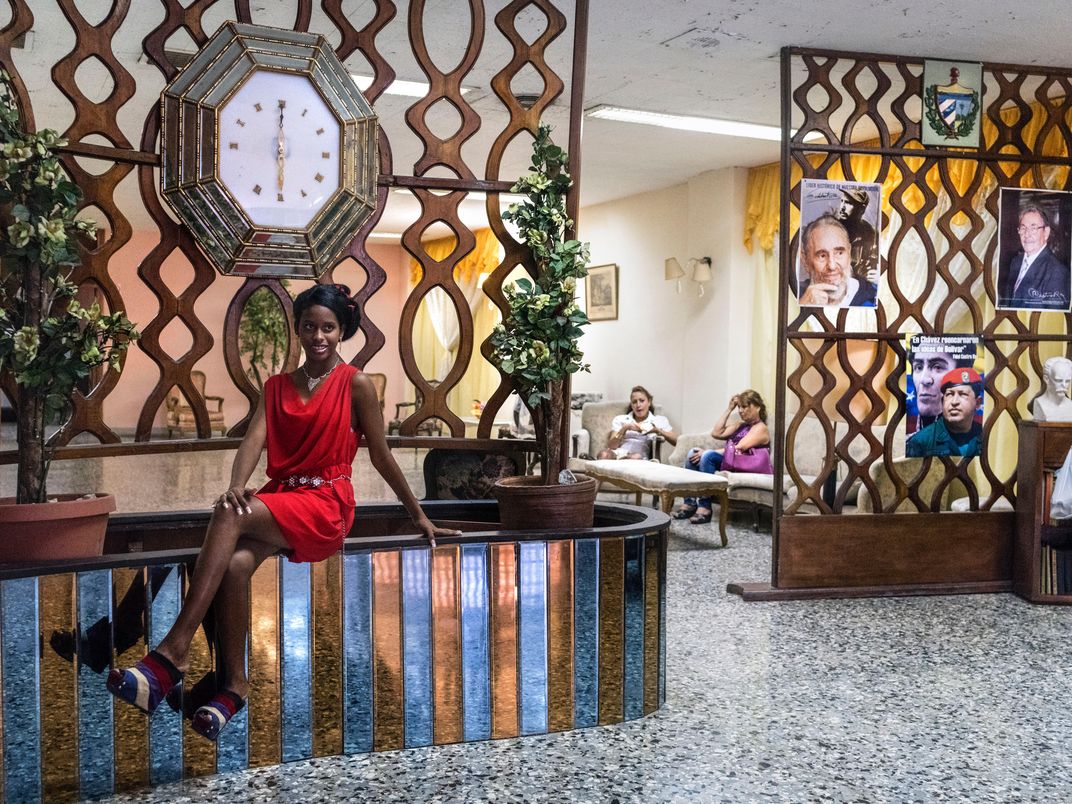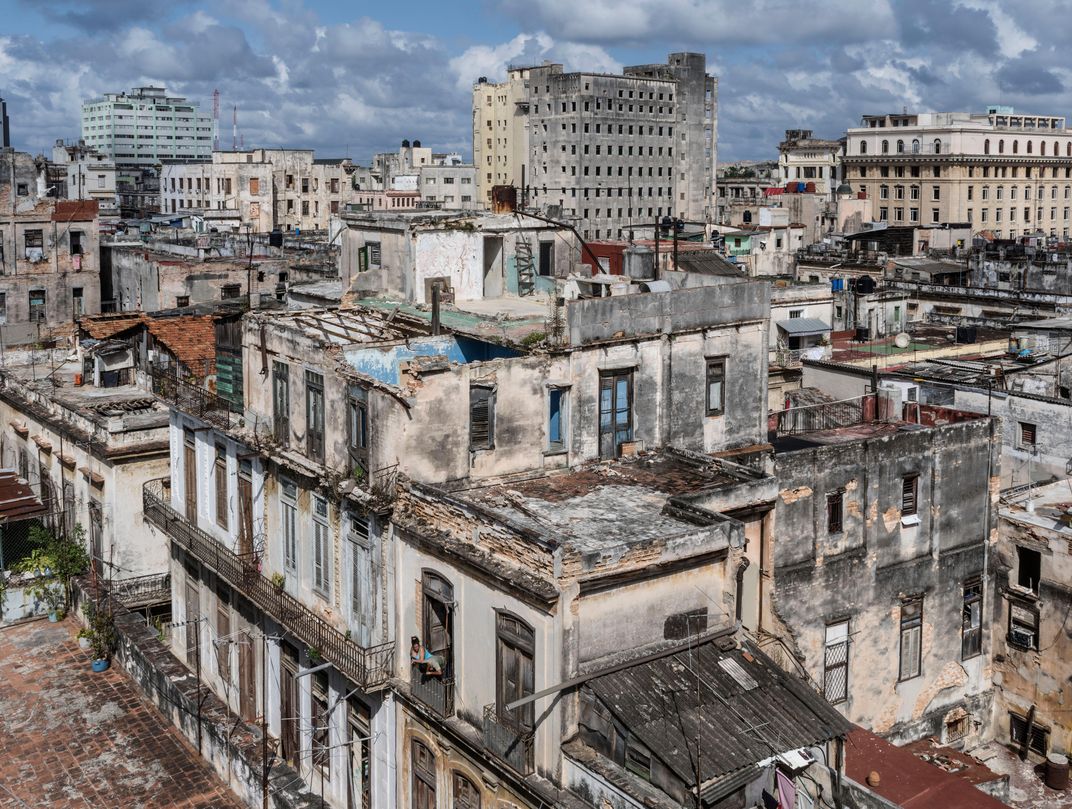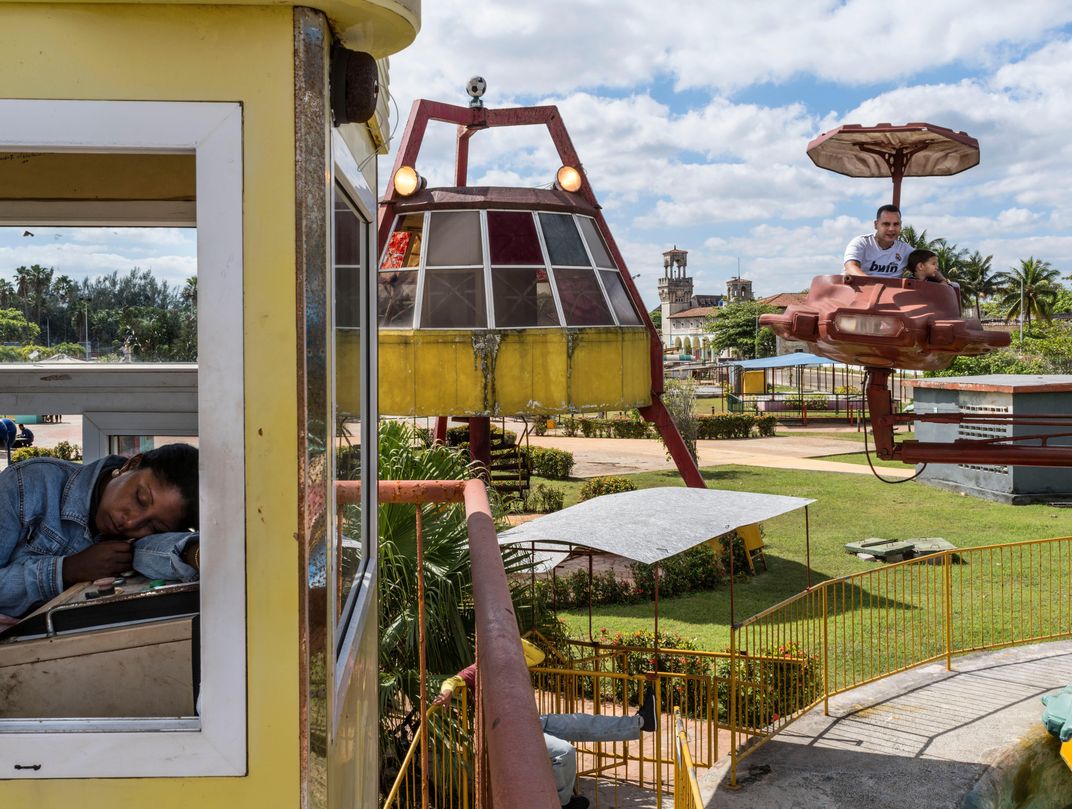Homage to Havana
A Smithsonian director ponders the allure of Cuba’s capital city
:focal(1309x621:1310x622)/https://tf-cmsv2-smithsonianmag-media.s3.amazonaws.com/filer/3d/f2/3df2df21-cc45-4766-b630-85a31a91edff/a6e73de2c2f55e7db6d6e3d5defdec42e1f490c8-1.jpg)
One afternoon in Havana, while I was walking along the Malecón, a young boy caught my attention. He was playing on top of the thick, cement gray seawall of the esplanade that runs along most of the northern coast of the city. I was only a few hours into my first research trip to Cuba. After unpacking my suitcase, I had bounded out to explore the city, heading first to the Malecón, where I knew Cubans congregated for all sorts of fun—swimming, dancing, hanging out.
The boy was waifish and thin but not afraid to make eye contact. He approached me, speaking in the rapid, singsong accent of Havana’s residents.
“Where are you from?”
“The U.S.”
“Americano! Really?” He had reason to wonder. It was 1992, and there were very few Americans in Cuba at the time. The boy, who I learned was named Armando, asked why I was in the city. I explained that I was doing research on the country’s African-inspired religions. He asked if I was a believer, and when I told him that I was, he invited me to his home, explaining that his father was an important priest and his mother had just been initiated as a priestess.
**********
We walked a couple of blocks to a spartan second-story walk-up, and his mother, Emilia, welcomed me warmly into their home, even though I was total stranger. It was the “special period,” just after the Soviets had withdrawn their subsidies for the Cuban economy, and everything was in short supply. Still, she made me coffee, and we sat down to talk. When she asked why I was in Havana, I told more of the story: I was there to do research on the Afro-Cuban religion commonly called Santería but also to become a priest in the tradition. She asked if I knew anyone who could help me along this path. I told her I had spoken to friends and colleagues in the States, so I’d come prepared with a list of potential people.
She gently pressed me. She wanted names. I ran through the first few, and then I mentioned Norma Pedroso. She asked how I knew Norma.
“Her brother Santiago, in Philadelphia, is a friend of mine.”
Emilia put down her coffee cup, and looked straight at me, her eyes gleaming. “I used to be married to Santiago Pedroso. He and I have a daughter, named for his sister Norma. Norma is a good woman, and you will not go wrong with her.” Three weeks later Santiago’s sister initiated me, and when I saw her this past April, this good woman had become an old friend.
One is always making connections of this kind in Cuba, as the years would teach me.
**********
Think of me as your man in Havana. I probably started out, 24 years ago, as naive as the character from the Graham Greene novel. I went with the idea that I could focus narrowly on religious culture and heritage, but I soon learned that the wide world of geopolitics impacted almost every aspect of daily life on the island. Strong personalities at many levels of society make for a good deal of arbitrary behavior, so Cuba is complicated, unpredictable, and sometimes maddening.
Some authors have ventured a theory or hypothesis for Cuba, but I am not that brave. The “island of marvels,” as it is sometimes called, is actually an archipelago of more than a thousand islands and keys. It includes the dense urban jungle of downtown Havana, rain forests, swamps, and near deserts. And each location has a thicket of interlocking stories about its history and its inhabitants—people, plants, animals, and spirits.
These stories are told in the very distinct Spanish that Cubans speak, using vocabulary overflowing with African words and an intensely melodic intonation. Cubans delight in these stories, whether they chronicle romance or betrayal, history or heroism.
Many Cuba experts have tried to identify the singular element in the culture that makes it so distinctive. Most people sense it when they visit, and Cubans themselves sometimes allude to it as chispa, a certain kind of spark or moxie. Chispa exists in performance and rhythm, in the nation’s colors, style, and intensity. In creativity that seems to come as effortlessly as snapping your fingers. There’s a certain way that musicians tap out the rhythm of the clave, the syncopated beat of most Cuban music. There is a certain way that baseball fans gather to argue about their favorite teams and players. And there is a certain way that housewives and workers line up to wait for the bus. Not everything can be explained by chispa, to be sure, but you’re likely to be struck immediately by the omnipresence of style—so much style.

**********
Cuba is a powerful place. You cannot visit the island without noticing its exquisite geography. And Havana rarely disappoints. Even the street names conjure up small stories from the past and make you share in them as you enunciate with care.
Aranguren, named for Col. Néstor Aranguren, who died fending off Spanish forces in the war for independence.
Bayona, as in count of the house of Bayona. One José de Bayona y Chacón, Fernández de Córdoba y Castellón had been mayor of Havana a couple of times before 1721, when he bought a title from the Spanish crown for 20,000 ducats.
Crespo street is more difficult. It could be for Bartolomé Crespo, who quit his studies to dedicate himself to literature and produced popular satires in Afro-Cuban slang, but it’s probably for Arcadio, another hero in the long struggle for independence.
Muralla traces the outline of the fortifications that enclosed the city for centuries.
San Lázaro begins where the old leprosarium was located, next to the seawall.
San Nicolás reflects a time when Catholicism had an official hold on the city.
Teniente Rey translates as “viceroy” and evokes Spain’s empire.
Zanja, or ditch, follows the course of the canal that channeled water from a river to the east of the walled city.
You could cover the whole alphabet this way and not even make it across town.
Most confounding to newcomers, every postal address includes the street name and building number, plus the two cross streets. For example, I have an old friend who lives at Zanja No. 732, between Aramburu and Hospital. Another lives at Lacret No. 508, between Juan Delgado and Goicuria. Each address is like a sound collage with specific coordinates but a distinctive Cuban rhythm, like a poem from Nicolás Guillén’s Sóngoro Cosongo, which turns the specific cadences and characteristic syllables of Afro-Cuban speech into unforgettable verses.

**********
This landscape becomes the stage for astonishing moments, glimpses into Havana’s particular way of being. And the island of wonders is sometimes unbelievably dull, so you should never forget that all these exceptional moments truly stand out. Uruguayan Eduardo Galeano’s Book of Embraces tells one such story about Havana. (The book is both fact and fiction and the story is either true or true to type.) A bus driver sees an attractive woman on the street, slows the bus, opens the door, and begins to flirt with her. After several blocks, the driver stops the bus, descends the steps, and follows his siren into the city. The passengers are left at loose ends until one of them takes the wheel and drives to his stop and disembarks. One after another, different passengers step up, drive to their stops, and get off. This continues until the bus comes to the end of its route.
**********
Late one afternoon in the winter of 1995, after a long day of interviewing people, I rode my bike home along the city’s esplanade—not far from where I met Armando. A rainstorm had just washed over the city, and everything was still wet. As my bike splashed through a huge puddle near the Hermanos Ameijeiras Hospital, I noticed an old man standing on the seawall, facing the bay. His white hair made a stark contrast with his dark skin and the deep gray-blue of the stormy sea. He was pounding on a guitar and pouring his heart into a song to the water.
I stopped to listen but did not disturb him. Was his song dedicated to Yemayá, the generous great mother of the sea? Did he just need to get out of his apartment after the storm? Or was this just the idiosyncratic habit of an unusual old man? No matter his motives, you could hear the skill in his playing and the passion in his voice.
A few years later, when the Buena Vista Social Club took the world by storm in the late 1990s, I was surprised to see the face of the old man in the album art. He was none other than Ibrahim Ferrer, the brilliant vocalist who played with bandleader Pacho Alonso and the legendary Benny Moré in the 1950s before becoming part of the Buena Vista Social Club. Anywhere else, this sort of surprising performance might have seemed strange, but in Havana a marvelous concert played for the sea is part of everyday reality.
**********
My friend Erasmo Rey Palma never tires of telling a story about his father, who had worked as a seasonal sugarcane cutter before the revolution. Erasmo says his father remembers going hungry every year, when the family ran out of money a few months before the harvest. But after the 1959 revolution, when times were good, his father would prepare lechón, roast pork, on Christmas Eve. He always bought two pigs, one large and one small. He hung them outside over the patio and poured boiling water on their skin to make their tiny hairs stand up. He shaved each one with great care. (Making lechón is tedious work.) He marinated the pork in bitter orange juice with cumin, garlic, and onions. Then he carefully roasted the two pigs side by side.
The large pig went to the family table for everyone to share. The small one was his private prize, and he would eat every last scrap of meat with his bare hands. When he had finished this celebration of excess, his hands would be covered in the juices and fat from the pork, and he would bring them together and cover his face. Then he would run them up over his face and head, anointing himself with the remains of the feast. This idiosyncratic delight in the pleasures of life is all the more poignant given the long history of scarcity that marks the personal story of this man and the island as a whole.
**********
It is no surprise that these are the same people who are credited with inventing magical realism. Cuban author Alejo Carpentier wrote passionately about the “marvelous real” as a way to approach the improbable and effusive tropical environment as well as the surprising nature of history in this part of the world. Gabriel García Márquez is said to have encountered Carpentier after penning the first draft of A Hundred Years of Solitude and decided to rewrite the whole book to infuse it with magical or unreal elements.
“It is neither beautiful nor ugly; rather, it is amazing because it is strange. Everything strange, everything amazing, everything that eludes established norms is marvelous,” Carpentier wrote in his 1975 essay “The Baroque and the Marvelous Real.” The baroque, he says, “is an art in motion, an art of propulsion, an art that goes from a center toward the outside and breaks its own margins.”
This constant movement in multiple directions is endlessly interesting in architecture and politics, literature and religion. In fact, some Cubans even refer to themselves as having baroque personalities, filled with contradictions and paradoxes that they celebrate. Carpentier cited Afro-Cuban religious altars as evidence of spontaneous surrealism in Cuba, because they unite many disparate objects and images to evoke and honor the deities.

**********
At the heart of Santería sits a trickster god, an unreliable but helpful messenger who everyone ironically relies upon for communication between humans and the heavens. His name is Elegguá, and he appears in dreams to make claims on your reality. He is always the first and last deity honored in ceremonies. Cuban adepts commonly say that he closes the road to difficulties and opens the road to blessings. He appears both as a child and as an old man. He places people on your path, like that boy I met on the Malecón. Uniting all opposites, Elegguá controls life and death. Across the city, he is honored with ceremonies at the crossroads, signifying life’s intersections, where differing paths meet, choices are made, and the meaning of those choices becomes real. Dynamic and vital, he propels Cuban believers toward a future built from their skills, their chispa, and their objective conditions. As Galeano says in “Celebration of Contradictions,” a panegyric to both Elegguá and the marvelous real, “We are the sum of our efforts to change who we are…the endlessly astonishing synthesis of the contradictions of everyday life.”
That ever changing and always surprising quotidian reality, the unexpected connections that I have come to expect, are what make Havana my favorite place on Earth.
Read more from the Smithsonian Journeys Travel Quarterly Cuba Issue
/https://tf-cmsv2-smithsonianmag-media.s3.amazonaws.com/accounts/headshot/Mason_Michael-12012.jpg)


/https://tf-cmsv2-smithsonianmag-media.s3.amazonaws.com/accounts/headshot/Mason_Michael-12012.jpg)